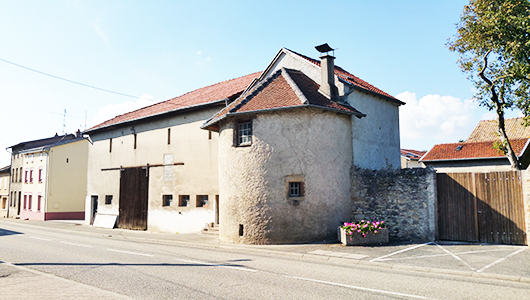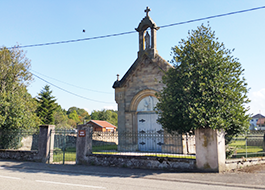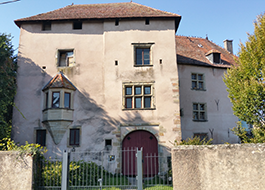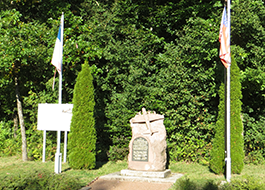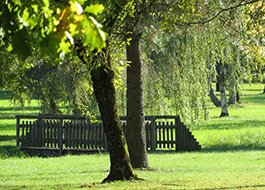Réchicourt-le-Château
Durée visite : 150 minutes
Moyen : Pédestre
Réchicourt ou Ruxinga en germanique médiéval, est déjà mentionné en 770. En 1255, le comte de Réchicourt fait hommage à l’évêque de Metz pour le château de Réchicourt. Le comté de Réchicourt relevait en fief du bailliage d’Allemagne. Il s’agissait des possessions germanophones du duché de Lorraine. En 1681, le comte Frédéric d’Ahlefeldt fait hommage au roi de France pour le comté de Réchicourt. La seigneurie reste terre d’Empire après le rattachement de la Lorraine à la France en 1766. De 1751 à 1789 le comté appartient à la famille du duc de Fronsac-Richelieu. Réchicourt est annexé par la République française à la Révolution. Il fait partie du département de la Meurthe. En 1871, Réchicourt est annexé à l’Empire allemand par le traité de Francfort. En 1919, il redevient une commune française du département de la Moselle. De lourdes destructions marquent le village lors de la Seconde Guerre mondiale.
Réchicourt or Ruxinga in medieval Germanic, was already mentioned in 770. In 1255, the count of Réchicourt paid homage to the bishop of Metz for the castle of Réchicourt. The county of Réchicourt came under the fief of the Bailiwick of Germany. These were the German-speaking possessions of the Duchy of Lorraine. In 1681, Count Frédéric d’Ahlefeldt paid homage to the King of France for the County of Réchicourt. The seigneury remained Empire land after Lorraine was joined to France in 1766. From 1751 to 1789 the county belonged to the family of the Duke of Fronsac-Richelieu. Réchicourt is annexed by the French Republic to the Revolution. It is part of the Meurthe department. In 1871, Réchicourt was annexed to the German Empire by the Treaty of Frankfurt. In 1919, it again became a French commune in the Moselle department. Heavy destruction marked the village during the Second World War.
Réchicourt oder Ruxinga im mittelalterlichen Germanischen wurde bereits 770 erwähnt. 1255 huldigte der Graf von Réchicourt dem Bischof von Metz für die Burg von Réchicourt. Die Grafschaft Réchicourt stand unter dem Lehen der Vogtei von Deutschland. Dies waren die deutschsprachigen Besitztümer des Herzogtums Lothringen. 1681 huldigte Graf Frédéric d’Ahlefeldt dem König von Frankreich für die Grafschaft Réchicourt. Das Seigneury blieb Reichsland, nachdem Lothringen 1766 mit Frankreich verbunden wurde. Von 1751 bis 1789 gehörte die Grafschaft der Familie des Herzogs von Fronsac-Richelieu. Réchicourt wird von der Französischen Republik an die Revolution angeschlossen. Es ist Teil der Abteilung Meurthe. 1871 wurde Réchicourt durch den Frankfurter Vertrag dem Deutschen Reich angegliedert. 1919 wurde es wieder eine französische Gemeinde im Departement Mosel. Schwere Zerstörungen kennzeichneten das Dorf während des Zweiten Weltkriegs.

De gueules semé de croix recroisettées au pied fiché d’or, à deux saumons adossés du même.
Ce sont les armes de l’ancienne famille chevaleresque de Réchicourt, qui posséda la seigneurie du XIIe au XIVe siècles, telles qu’elles figurent sur le sceau de Wiry de 1255 et de nombreux sceaux des Archives dép. de Meurthe-et-Moselle, en particulier le sceau équestre de Simon, du XIIe siècle. (B 481, catalogue des Robert, N° 678) ; toutefois, sur les fragments du sceau du comte Sigebert, XIIe s. (H 1244, catalogue des Robert, N° 677), on voit un château à deux ou trois tours. La bannière qui se trouve dans la basilique de Saint-Nicolas-de-Port rappelle la délivrance miraculeuse de Conon de Réchicourt, transporté, par l’intervention de saint Nicolas, de la prison de la tour noire, près de Constantinople, dans la basilique de Saint-Nicolas-de-Port. Une procession, où étaient jadis portées la bannière et les chaînes de Conon, faite le 5 décembre, à 8 heures du soir, commémore cet événement. Après l’extinction de la famille de Réchicourt, le comté fut possédé par la maison de Linange. Réchicourt-le-Château est titulaire de la croix de guerre 1939-1945 (citation à l’ordre de la Division).
Gules sown with crosses crisscrossed to the foot stuck in gold, with two backing salmon of the same.
These are the arms of the old knightly family of Réchicourt, which owned the seigneury from the 12th to the 14th centuries, as they appear on the seal of Wiry of 1255 and many seals of the Archives dep. of Meurthe-et-Moselle, in particular the equestrian seal of Simon, from the 12th century. (B 481, catalog des Robert, No. 678); however, on the fragments of the seal of Count Sigebert, 12th century. (H 1244, catalog des Robert, N ° 677), we see a castle with two or three towers. The banner which is in the basilica of Saint-Nicolas-de-Port recalls the miraculous deliverance of Conon de Réchicourt, transported, by the intervention of Saint Nicolas, from the prison of the black tower, near Constantinople, in the basilica of Saint-Nicolas-de-Port. A procession, in which the banner and chains of Conon were once carried, on December 5 at 8 p.m. commemorates this event. After the extinction of the Réchicourt family, the county was owned by the house of Linange. Réchicourt-le-Château is the holder of the Croix de Guerre 1939-1945 (citation to the order of the Division).
Gules säte mit Kreuzen, die bis zum Fuß gekreuzt waren und in Gold steckten, mit zwei aufeinanderfolgenden Lachsen desselben.
Dies sind die Wappen der alten Ritterfamilie von Réchicourt, die vom 12. bis 14. Jahrhundert das Seigneury besaß, wie sie auf dem Siegel von Wiry von 1255 und vielen Siegeln des Archivs dep. von Meurthe-et-Moselle, insbesondere das Pferdesiegel von Simon, aus dem 12. Jahrhundert. (B 481, Katalog des Robert, Nr. 678); jedoch auf den Fragmenten des Siegels des Grafen Sigebert, 12. Jahrhundert. (H 1244, Katalog des Robert, Nr. 677) sehen wir eine Burg mit zwei oder drei Türmen. Das Banner in der Basilika Saint-Nicolas-de-Port erinnert an die wundersame Befreiung von Conon de Réchicourt, die durch die Intervention des Heiligen Nicolas aus dem Gefängnis des schwarzen Turms in der Nähe von Konstantinopel in die Basilika transportiert wurde von Saint-Nicolas-de-Port. Eine Prozession, in der einst das Banner und die Ketten von Conon getragen wurden, findet am 5. Dezember um 20 Uhr statt und erinnert an dieses Ereignis. Nach dem Aussterben der Familie Réchicourt war die Grafschaft im Besitz des Hauses Linange. Réchicourt-le-Château ist Inhaber des Croix de Guerre 1939-1945 (unter Berufung auf den Befehl der Division).

Lés mèrchands d’ couchons d’ Echico = les marchands de cochons de Réchicourt.
Les marchands de porcelets, établis dans ce village, étaient bien connus dans toute là région. Les affaires qu’ils traitaient étaient si importantes que leurs compatriotes ont dû accepter bon gré, mal gré le sobriquet collectif que les villageois des environs leur conféraient.
Réf. Les Evangiles d’lmling
Lés mèrchands d’ couchons d’ Echico = the Réchicourt pig merchants.
The piglet merchants, established in this village, were well known throughout the region. The business they dealt with was so important that their compatriots had to willingly, unwillingly, accept the collective nickname that the villagers of the surrounding area gave them.
Ref. The gospels of lmling
Lés mèrchands d’ couchons d’ Echico = die Schweinehändler in Réchicourt.
Die in diesem Dorf ansässigen Ferkelhändler waren in der gesamten Region bekannt. Das Geschäft, mit dem sie sich befassten, war so wichtig, dass ihre Landsleute bereitwillig und unfreiwillig den kollektiven Spitznamen akzeptieren mussten, den die Dorfbewohner der Umgebung ihnen gaben.
Ref. Die Evangelien von lmling

Les habitants et les habitantes de Réchicourt-le-Château s’appellent les Réchicourtois et les Réchicourtoises.
The inhabitants of Réchicourt-le-Château are called Réchicourtois and Réchicourtoises.
Die Einwohner von Réchicourt-le-Château heißen Réchicourtois und Réchicourtoises.
Les points de visites
.
Un ermitage de Saint-Blaise existait depuis le XVIe siècle. Il se trouvait à la lisière du bois entre Mussey et Réchicourt. Il fut abandonné à la Révolution par son ermite, Dominique Claudon. Sa cloche, datant de 1669, fut vendue et acquise par un habitant de Foulcrey. La chapelle actuelle a été édifiée à l’emplacement du cimetière et fut bénie en 1880. Elle a été reconstruite par l’abbé Loué, curé de Réchicourt de 1866 à 1890. Elle se situe à la sortie du village sur la route allant à Gondrexange. La chapelle est ouverte au culte en 1881. C’est un édifice d’une pureté simple situé dans un petit enclos. Une vieille et vénérable cloche de 1669 y a également trouvé sa place. Elle sonne pour les dévotions de Saint-Blaise. Mais elle était utilisée encore à l’approche des orages. Jusqu’à 1954, chaque année de nombreux pèlerins venaient le 03 février, fête de Saint-Blaise. Ils faisaient bénir les paniers contenant des semences et des produits de la terre.
A hermitage of Saint-Blaise had existed since the 16th century. He was on the edge of the woods between Mussey and Réchicourt. He was abandoned during the Revolution by his hermit, Dominique Claudon. Its bell, dating from 1669, was sold and acquired by an inhabitant of Foulcrey. The current chapel was built on the site of the cemetery and was blessed in 1880. It was rebuilt by Father Loué, priest of Réchicourt from 1866 to 1890. It is located at the exit of the village on the road going to Gondrexange . The chapel was opened for worship in 1881. It is a building of simple purity located in a small enclosure. An old and venerable bell from 1669 has also found its place here. It rings for the devotions of Saint-Blaise. But it was still used when thunderstorms approached. Until 1954, every year many pilgrims came on February 3, feast of Saint-Blaise. They blessed the baskets containing seeds and products of the earth.
Seit dem 16. Jahrhundert gab es eine Einsiedelei von Saint-Blaise. Er war am Waldrand zwischen Mussey und Réchicourt. Er wurde während der Revolution von seinem Einsiedler Dominique Claudon verlassen. Die Glocke aus dem Jahr 1669 wurde von einem Einwohner von Foulcrey verkauft und erworben. Die heutige Kapelle wurde an der Stelle des Friedhofs erbaut und 1880 gesegnet. Sie wurde von 1866 bis 1890 von Pater Loué, dem Priester von Réchicourt, wieder aufgebaut. Sie befindet sich am Ausgang des Dorfes an der Straße nach Gondrexange . Die Kapelle wurde 1881 für Gottesdienste geöffnet. Es handelt sich um ein Gebäude von einfacher Reinheit, das sich in einem kleinen Gehege befindet. Hier hat auch eine alte und ehrwürdige Glocke aus dem Jahr 1669 ihren Platz gefunden. Es klingelt für die Andachten von Saint-Blaise. Aber es wurde immer noch benutzt, wenn sich Gewitter näherten. Bis 1954 kamen jedes Jahr viele Pilger am 3. Februar, dem Fest von Saint-Blaise. Sie segneten die Körbe mit Samen und Produkten der Erde.
.
.
Le village a connu deux châteaux. Un château médiéval, du XIIe siècle, appelé Le Collignon. Vers 1469, il est détruit au cours d’un conflit entre le comte Rudolphe de Linange et le duc de Lorraine. Il est entièrement rasé en 1879. Les pierres ont servi à la gare de Nouvel-Avricourt. Un château est édifié au XVIe siècle suite à un partage. Remanié au XVIIe siècle, il est agrandi au XVIIIe siècle. Le bâtiment conserve de cette époque le logis, un escalier et deux pièces à l’étage, une grange, ainsi que les restes de l’enceinte fortifiée.
The village has known two castles. A medieval castle, from the 12th century, called Le Collignon. Around 1469, it was destroyed during a conflict between Count Rudolphe de Linange and the Duke of Lorraine. It was completely razed in 1879. The stones were used at the Nouvel-Avricourt station. A castle was built in the 16th century following a sharing. Redesigned in the 17th century, it was extended in the 18th century. The building retains from this period the house, a staircase and two rooms upstairs, a barn, as well as the remains of the fortified enclosure.
Das Dorf hat zwei Burgen gekannt. Eine mittelalterliche Burg aus dem 12. Jahrhundert namens Le Collignon. Um 1469 wurde es während eines Konflikts zwischen Graf Rudolphe de Linange und dem Herzog von Lothringen zerstört. Es wurde 1879 vollständig zerstört. Die Steine wurden an der Station Nouvel-Avricourt verwendet. Nach einer gemeinsamen Nutzung wurde im 16. Jahrhundert eine Burg erbaut. Im 17. Jahrhundert neu gestaltet, wurde es im 18. Jahrhundert erweitert. Das Gebäude bewahrt aus dieser Zeit das Haus, eine Treppe und zwei Räume im Obergeschoss, eine Scheune sowie die Überreste des befestigten Geheges.
.
Le 8 septembre 1944, 1070 bombardiers B-17 et 653 autres avions quittent l’Angleterre dans le cadre de la mission 611 : bombarder les installations pétrolières de Ludwigshafen, Karlsruhe, Gustavenburg et Kassel. Le B-17 « Shady Lady » participe à la mission 611. Il a décollé de la base 131 de Nuthampstead au nord de Londres. Au retour, 3 des 4 moteurs tombent en panne et le dernier donne des signes de faiblesse. 2 membres d’équipage sautent en parachute. Le pilote réussit cependant à poser le quadrimoteur, train sorti, dans un champ à Ley. Malheureusement, cet endroit, situé à environ 20 kilomètres à l’ouest de Réchicourt-le-Château, est en territoire occupé. Les 7 membres d’équipages sont arrêtés . Ils profitent de leur transfert en camion pour tenter de s’évader. 3 seront tués et enterrés à Haguenau. Les 4 autres sont blessés. 2 seront envoyés au stalag de Barth et les 2 derniers au camp de prisonniers de Pomeria. Ce monument en grès rose des Vosges est érigé en 2008, sculpté par Serge Didot.
On September 8, 1944, 1,070 B-17 bombers and 653 other planes left England as part of mission 611: to bomb the oil installations of Ludwigshafen, Karlsruhe, Gustavenburg and Kassel. The B-17 « Shady Lady » participates in mission 611. It took off from base 131 at Nuthampstead in North London. On the way back, 3 of the 4 engines failed and the last one gave signs of weakness. 2 crew members parachute. The pilot, however, succeeded in landing the four-engine, gear extended, in a field at Ley. Unfortunately, this place, located about 20 kilometers west of Réchicourt-le-Château, is in occupied territory. The 7 crew members are arrested. They take advantage of their transfer by truck to try to escape. 3 will be killed and buried in Haguenau. The other 4 are injured. 2 will be sent to the Barth stalag and the last 2 to the Pomeria prison camp. This monument in pink sandstone from the Vosges was erected in 2008, sculpted by Serge Didot.
Am 8. September 1944 verließen 1.070 B-17-Bomber und 653 andere Flugzeuge England im Rahmen der Mission 611, um die Ölanlagen von Ludwigshafen, Karlsruhe, Gustavenburg und Kassel zu bombardieren. Die B-17 « Shady Lady » nimmt an Mission 611 teil. Sie startete von der Basis 131 in Nuthampstead im Norden Londons. Auf dem Rückweg fielen 3 der 4 Motoren aus und der letzte gab Anzeichen von Schwäche. 2 Besatzungsmitglieder Fallschirm. Dem Piloten gelang es jedoch, das viermotorige Getriebe auf einem Feld in Ley zu landen. Leider befindet sich dieser Ort, etwa 20 Kilometer westlich von Réchicourt-le-Château, auf besetztem Gebiet. Die 7 Besatzungsmitglieder werden festgenommen. Sie nutzen ihren Transfer per LKW, um zu fliehen. 3 werden in Haguenau getötet und begraben. Die anderen 4 sind verletzt. 2 werden zum Barth Stalag und die letzten 2 zum Pomeria Gefangenenlager geschickt. Dieses Denkmal aus rosa Sandstein aus den Vogesen wurde 2008 von Serge Didot errichtet.
.
L’écluse de Réchicourt-le-Château, sur le canal de la Marne au Rhin, est un ouvrage d’art construit en 1965. L’écluse a une hauteur de chute d’environ 16 m, selon le niveau d’eau dans le canal. C’est la plus haute de France. Elle remplace six écluses plus anciennes. Elle permet ainsi un passage de bateau en trente minutes. Il fallait autrefois six heures pour la même opération. Cette écluse française a la plus grande hauteur de chute sur un canal au gabarit Freycinet. Le compartiment de l’écluse a une profondeur minimale de 2,6 m, une largeur de 6 m et une longueur de 40 m, pour un volume de 3 768 m3 environ. À l’aval, l’eau est bloquée par une porte levante. A l’amont, ce sont deux portes à battants de 20 m de haut qui assurent la fermeture. L’ensemble des organes (portes et vannes) est manœuvré par des vérins hydrauliques et piloté depuis une cabine de manœuvre. 3000 bateaux de petit gabarit y passent chaque année. On peut encore observer les anciennes écluses à proximité de l’écluse moderne.
The Réchicourt-le-Château lock, on the Marne-Rhine canal, is an engineering structure built in 1965. The lock has a drop height of around 16 m, depending on the water level in the lock. the canal. It replaces six older locks. It thus allows a boat passage in thirty minutes. It used to take six hours for the same operation. This French lock has the greatest drop height on a Freycinet gauge canal. The lock compartment has a minimum depth of 2.6 m, a width of 6 m and a length of 40 m, for a volume of approximately 3,768 m3. Downstream, the water is blocked by a lifting door. Upstream, two 20 m high swing doors ensure the closure. All the components (doors and valves) are operated by hydraulic jacks and controlled from an operating cabin. You can still see the old locks near the modern lock.
Die Schleuse Réchicourt-le-Château am Marne-Rhein-Kanal ist ein Bauwerk aus dem Jahr 1965. Die Schleuse hat je nach Wasserstand in der Schleuse eine Fallhöhe von ca. 16 m. der Kanal. Es ersetzt sechs ältere Schlösser. Es ermöglicht somit eine Bootspassage in 30 Minuten. Früher dauerte der gleiche Vorgang sechs Stunden. Diese französische Schleuse hat die größte Fallhöhe an einem Freycinet-Messkanal. Das Schlossfach hat eine Mindesttiefe von 2,6 m, eine Breite von 6 m und eine Länge von 40 m bei einem Volumen von ca. 3.768 m3. Stromabwärts wird das Wasser durch eine Hubtür blockiert. Stromaufwärts sorgen zwei 20 m hohe Schwingtüren für den Verschluss. Alle Komponenten (Türen und Ventile) werden über Hydraulikzylinder betrieben und von einer Bedienkabine aus gesteuert. Sie können immer noch die alten Schlösser in der Nähe des modernen Schlosses sehen.
.
L’étang de Réchicourt est divisé en deux parties par le canal de la Marne au Rhin. L’étang se trouve à une altitude de 250 mètres au-dessus du niveau de la mer.
Sur la partie de la rive Sud, depuis une trentaine d’années, se trouve sur plusieurs hectares un arboretum. Il agrémente les abords de l’étang principal. En 1973, le Conseil Municipal présidé par Monsieur Schwenck, Maire de la commune, décide d’aménager les abords de l’étang. Il agit dans le cadre de l’opération 100.000 arbres mise en place par l’Etat. En 2000 « Le Sentier dans les Arbres » est créé sur la longueur de l’arboretum. Il recense les variétés d’arbres que l’on peut trouver au fil de la promenade. Les informations sont diffusées de façon originale et ludique.
The Réchicourt pond is divided into two parts by the Marne-Rhine canal. The pond is at an altitude of 250 meters above sea level.
On the part of the south shore, for about thirty years, there is an arboretum on several hectares. It adorns the surroundings of the main pond. In 1973, the Municipal Council chaired by Mr. Schwenck, Mayor of the town, decided to develop the surroundings of the pond. It acts as part of the 100,000 trees operation set up by the State. In 2000 « Le Sentier dans les Arbres » was created along the length of the arboretum. It lists the varieties of trees that can be found along the walk. The information is disseminated in an original and fun way.
Der Réchicourt-Teich ist durch den Marne-Rhein-Kanal in zwei Teile geteilt. Der Teich liegt auf einer Höhe von 250 Metern über dem Meeresspiegel.
Auf dem Teil der Südküste befindet sich seit etwa dreißig Jahren ein Arboretum auf mehreren Hektar. Es schmückt die Umgebung des Hauptteichs. 1973 beschloss der Gemeinderat unter dem Vorsitz von Herrn Schwenck, Bürgermeister der Stadt, die Umgebung des Teiches zu entwickeln. Es ist Teil des vom Staat eingerichteten Betriebs mit 100.000 Bäumen. Im Jahr 2000 wurde « Le Sentier dans les Arbres » entlang der Länge des Arboretums geschaffen. Es listet die Baumarten auf, die entlang des Spaziergangs zu finden sind. Die Informationen werden auf originelle und unterhaltsame Weise verbreitet.

